SB 493 Expands Scope of Practice for Licensed Pharmacists
 In 2013, Governor Jerry Brown signed into law Senate Bill 493, authored by Senator Ed Hernandez, which for the first time ever, acknowledged pharmacists as legitimate healthcare providers and had also expanded the scope of practice for pharmacists to offer more patient care services beyond their most familiar function of drug dispensing. SB 493 was introduced in the Legislature as a response to the State’s physician shortage, especially after California had expanded coverage to millions of people under the Affordable Care Act.
In 2013, Governor Jerry Brown signed into law Senate Bill 493, authored by Senator Ed Hernandez, which for the first time ever, acknowledged pharmacists as legitimate healthcare providers and had also expanded the scope of practice for pharmacists to offer more patient care services beyond their most familiar function of drug dispensing. SB 493 was introduced in the Legislature as a response to the State’s physician shortage, especially after California had expanded coverage to millions of people under the Affordable Care Act.
One of the critical expanded authorities that came from SB 493 was the ability for all licensed pharmacists in the State to provide and offer nicotine replacement products for smoking cessation. Prior to SB 493, providing nicotine replacement therapy was limited to pharmacists who worked in either an inpatient setting or an integrated system.
Pharmacists Can Better Assist Patients with Smoking Cessation
Pharmacists who provide nicotine replacement therapy are not just selling the nicotine replacement products themselves, but they are also assisting patients with tobacco cessation using patient specific interventions, including referring patients to quitlines, such as the California Smokers’ Helpline, and other resources that are available within the community. Before a pharmacist even offers nicotine replacement therapy, they will evaluate their patients for any specific factors including precautions or contraindications for medication therapy. In addition, extensive counseling is done by the pharmacist with their patient on the appropriate use of smoking cessation medications such as dosing amounts, how to administer the product, and any possible adverse effects.
SB 493 opened the doors for retail and community pharmacists to be able to transform their business model by offering more preventative healthcare services, like nicotine replacement therapy. Most importantly, pharmacists have an opportunity to be leaders in the fight against nicotine addiction by decreasing the use of tobacco products and promoting smoking cessation especially since they interface with patients frequently throughout the day.
The health benefits for patients who participate in a smoking cessation program are incredible considering the damaging effects of nicotine addiction. Smoking tobacco products increases the chance of lung cancer, chronic obstructive pulmonary disease, coronary heart disease, stroke, and peripheral vascular disease among others.
Patient Access to Care Increased
Patients are particularly at an advantage of receiving nicotine replacement therapy from their community pharmacist because the service can be provided more accessibly, rather than having to make an appointment to see their primary care physician which can take several weeks. Patients who want to quit smoking and begin a smoking cessation program with their local pharmacist will see major improvements in their health and will significantly reduce the risk of premature death.
The California Pharmacists Association was instrumental in advocating for SB 493 (Hernandez) and were sponsors of the legislation. CPhA’s CEO, Jon Roth recalls that the timing of this legislation was impeccable. “SB 493 was looked upon by the pharmacy profession as the perfect storm. For years, pharmacists had been overlooked as healthcare providers who could play a significant role in improving health outcomes and reducing overall healthcare spending through their expertise in medication management. After the Affordable Care Act had passed, California’s Medi-Cal program grew to over 13 million beneficiaries, which is about a third of the state’s population. Physicians became overwhelmed and we saw that many were no longer accepting Medi-Cal patients. So the need for pharmacists to bridge this gap in care was not only imperative, but it just made sense.”
Protocol for Pharmacists Furnishing Nicotine Replacement Products
Once the bill was signed into law, the California Board of Pharmacy and the Medical Board of California were responsible for developing protocols for pharmacists to follow when providing the authorized services outlined in SB 493 and determining the appropriate training requirements.
The entire protocol and training requirements for pharmacists to furnish nicotine replacement products is available here and summarized as follows:
- Pharmacists have the authority to furnish nicotine replacement products approved by the FDA.
- The purpose is to provide timely access to nicotine replacement products and to ensure the patient receives the appropriate information to initiate smoking cessation medication therapy. When a pharmacist initiates or receives requests for smoking cessation treatment he or she must:
- Review the patient’s current tobacco use and quit attempts
- Ask the patient a series of screening questions outlined in the protocol
- Review instructions for use with every patient
- Recommend additional assistance and resources such as helplines or local programs
- Answer any questions the patient may have
- A pharmacist may select any nicotine replacement product (alone or in combination) from the list of therapies specified by the Board of Pharmacy which shall be updated and maintained on the Board’s website.
- The pharmacist shall notify the patient’s primary care provider of any prescription drugs or devices furnished to the patient for smoking cessation treatment.
- The pharmacist must document each nicotine replacement product provided and securely store this information in a patient medication record for at least three years.
- Before initiating any smoking cessation treatment, a pharmacist must complete a two hour continuing education program specific to smoking cessation therapy and nicotine replacement therapy.
- Pharmacists must complete ongoing continuing education focused on smoking cessation therapy every two years. Pharmacists must ensure that patient confidentiality and privacy are maintained.
Pharmacy Education for Furnishing Free NRT
Purdue College of Pharmacy has a 2.5 hour, home study course that fulfills the training requirement needed before initiating smoking cessation treatment. The course - Behavioral Counseling & Pharmacotherapy - has been approved by the Board of Pharmacy and can be accessed by visiting Rxforchange: https://rxforchange.ucsf.edu/continuing_education.php
Participants who complete the online program and successfully pass the post-test will receive 2.5 hours of Continuing Pharmacy Education Credit.
New Fact Sheet from the California Smokers' Helpline
In addition, pharmacists can utilize the latest fact sheet provided by the California Smokers Helpline on furnishing nicotine replacement therapy for smoking cessation.
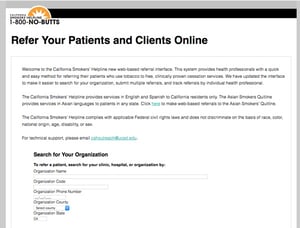 The California Smokers' Helpline is pleased to announce it's new interface for our free web-based referral service. Based on feedback we have received from referring providers, the interface has been revised to make it easier to search for your organization, submit multiple referrals, and track referrals by individual health professional.
The California Smokers' Helpline is pleased to announce it's new interface for our free web-based referral service. Based on feedback we have received from referring providers, the interface has been revised to make it easier to search for your organization, submit multiple referrals, and track referrals by individual health professional.








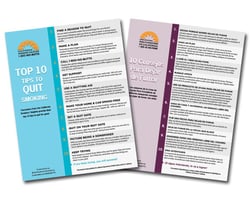 With the
With the 
 Oral diseases affect more people worldwide than any other chronic health condition of humankind. In addition to being a primary cause of major oral ailments, including oral cancer and gum disease, tobacco use disrupts nearly every facet of oral health: from taste perception, salivary flow, to the success of dental treatment.
Oral diseases affect more people worldwide than any other chronic health condition of humankind. In addition to being a primary cause of major oral ailments, including oral cancer and gum disease, tobacco use disrupts nearly every facet of oral health: from taste perception, salivary flow, to the success of dental treatment.
 Ms. Couch's research focuses on tobacco use in vulnerable populations and the role of dental professionals in tobacco prevention and cessation. Currently, she teaches in the Master of Science Degree Program in dental hygiene at UCSF and is the project coordinator of a longitudinal cohort study of tobacco use among adolescents in rural California. She holds an associate’s degree in dental hygiene from the Cabrillo College, a bachelor’s degree in biology from Cal Poly, San Luis Obispo and a master’s degree in dental hygiene from UCSF. She currently serves on the National Center for Dental Hygiene Research & Practice advisory board and is an active member of the California Dental Hygienists’ Association (CDHA), the American Dental Hygienists’ Association (ADHA), the American Dental Education Association (ADEA), and the International Association of Dental Research (IADR). In addition, she practices dental hygiene part-time where she is dedicated to addressing tobacco use among her patients.
Ms. Couch's research focuses on tobacco use in vulnerable populations and the role of dental professionals in tobacco prevention and cessation. Currently, she teaches in the Master of Science Degree Program in dental hygiene at UCSF and is the project coordinator of a longitudinal cohort study of tobacco use among adolescents in rural California. She holds an associate’s degree in dental hygiene from the Cabrillo College, a bachelor’s degree in biology from Cal Poly, San Luis Obispo and a master’s degree in dental hygiene from UCSF. She currently serves on the National Center for Dental Hygiene Research & Practice advisory board and is an active member of the California Dental Hygienists’ Association (CDHA), the American Dental Hygienists’ Association (ADHA), the American Dental Education Association (ADEA), and the International Association of Dental Research (IADR). In addition, she practices dental hygiene part-time where she is dedicated to addressing tobacco use among her patients.  Dr. Chaffee's research interests include tobacco-related behaviors and decision-making among adolescents, in particular how the marketing and regulation of smokeless tobacco influences tobacco use and health among rural youth. He is currently the lead investigator of cohort study of California rural high school male baseball players funded through the NIH/FDA Tobacco Regulatory Science program. Other research interests include how early life circumstances impact oral health and quality of life in childhood and the implementation of risk-based, prevention-oriented dental caries management in clinical settings. Dr. Chaffee is affiliated with the UCSF Center for Tobacco Control Research & Education, Global Health Sciences, the Helen Diller Family Comprehensive Cancer Center, and the Center to Address Disparities in Children's Oral Health. He serves as Director of the UCSF School of Dentistry Program in Global Oral Health.
Dr. Chaffee's research interests include tobacco-related behaviors and decision-making among adolescents, in particular how the marketing and regulation of smokeless tobacco influences tobacco use and health among rural youth. He is currently the lead investigator of cohort study of California rural high school male baseball players funded through the NIH/FDA Tobacco Regulatory Science program. Other research interests include how early life circumstances impact oral health and quality of life in childhood and the implementation of risk-based, prevention-oriented dental caries management in clinical settings. Dr. Chaffee is affiliated with the UCSF Center for Tobacco Control Research & Education, Global Health Sciences, the Helen Diller Family Comprehensive Cancer Center, and the Center to Address Disparities in Children's Oral Health. He serves as Director of the UCSF School of Dentistry Program in Global Oral Health. Tobacco and related products exert their addictive potential through nicotine. This webinar will review the mechanisms through which these products deliver nicotine and through which neural pathways nicotine exerts its effects on the brain.
Tobacco and related products exert their addictive potential through nicotine. This webinar will review the mechanisms through which these products deliver nicotine and through which neural pathways nicotine exerts its effects on the brain.
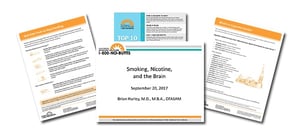 Our free Toolkit includes:
Our free Toolkit includes: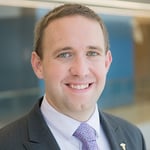 Brian Hurley, MD, MBA, DFASAM is an addiction psychiatrist and the Medical Director for Substance Use Related Care Integration at the Los Angeles County Health Agency. Brian is currently the Treasurer of the American Society of Addiction Medicine (ASAM) and gives presentations around the world related to addiction medicine. He is board certified in general psychiatry, addiction psychiatry, and addiction medicine.
Brian Hurley, MD, MBA, DFASAM is an addiction psychiatrist and the Medical Director for Substance Use Related Care Integration at the Los Angeles County Health Agency. Brian is currently the Treasurer of the American Society of Addiction Medicine (ASAM) and gives presentations around the world related to addiction medicine. He is board certified in general psychiatry, addiction psychiatry, and addiction medicine. Tobacco and related products exert their addictive potential through nicotine. This webinar will review the mechanisms through which these products deliver nicotine and the through which neural pathways nicotine exerts is effects on the brain.
Tobacco and related products exert their addictive potential through nicotine. This webinar will review the mechanisms through which these products deliver nicotine and the through which neural pathways nicotine exerts is effects on the brain.
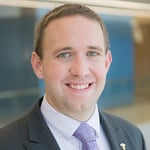 Brian Hurley, MD, MBA, DFASAM is an addition psychiatrist and the Medical Director for Substance Use Related Care Integration at the Los Angeles County Health Agency. Brian is currently the Treasurer of the American Society of Addiction Medicine (ASAM) and gives presentations around the world related to addiction medicine. He is board certified in general psychiatry, addiction psychiatry, and addiction medicine.
Brian Hurley, MD, MBA, DFASAM is an addition psychiatrist and the Medical Director for Substance Use Related Care Integration at the Los Angeles County Health Agency. Brian is currently the Treasurer of the American Society of Addiction Medicine (ASAM) and gives presentations around the world related to addiction medicine. He is board certified in general psychiatry, addiction psychiatry, and addiction medicine. The
The 
 In 2013, Governor Jerry Brown signed into law Senate Bill 493, authored by Senator Ed Hernandez, which for the first time ever, acknowledged pharmacists as legitimate healthcare providers and had also expanded the scope of practice for pharmacists to offer more patient care services beyond their most familiar function of drug dispensing. SB 493 was introduced in the Legislature as a response to the State’s physician shortage, especially after California had expanded coverage to millions of people under the Affordable Care Act.
In 2013, Governor Jerry Brown signed into law Senate Bill 493, authored by Senator Ed Hernandez, which for the first time ever, acknowledged pharmacists as legitimate healthcare providers and had also expanded the scope of practice for pharmacists to offer more patient care services beyond their most familiar function of drug dispensing. SB 493 was introduced in the Legislature as a response to the State’s physician shortage, especially after California had expanded coverage to millions of people under the Affordable Care Act.